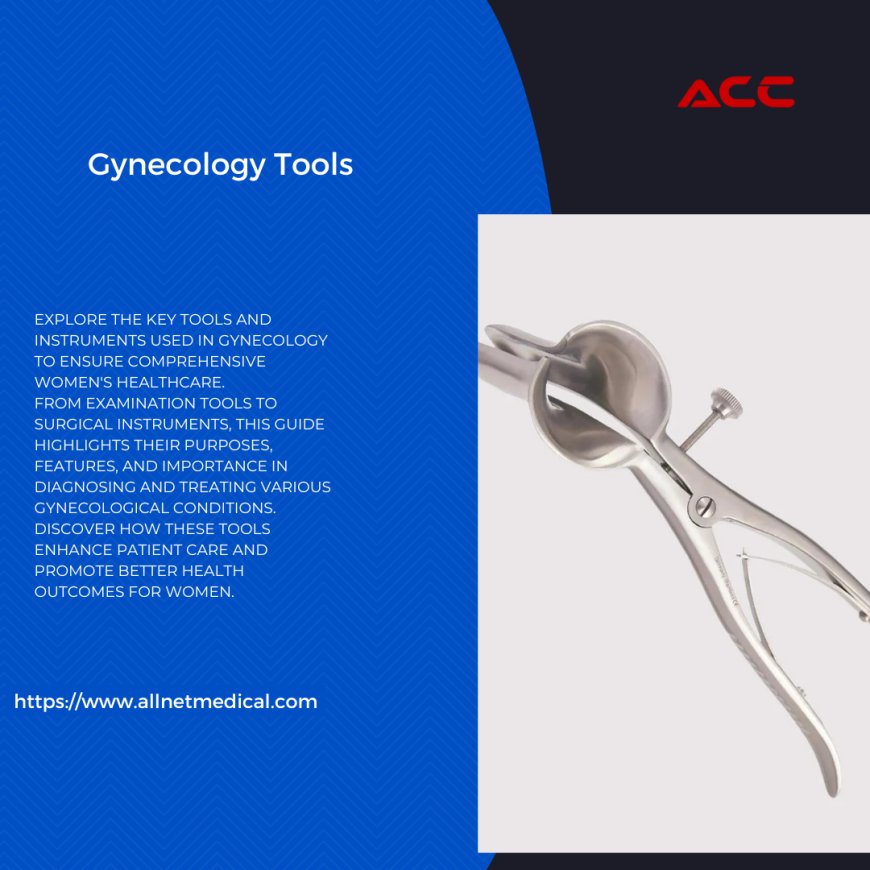Gynecology Tools in Modern Healthcare
Gynecology tools, also referred to as gynecological tools or gynecology instruments, have transformed the way healthcare professionals deliver care to women
Gynecology tools, also referred to as gynecological tools or gynecology instruments, have transformed the way healthcare professionals deliver care to women. From routine exams to complex surgical procedures, these specialized instruments offer a wide range of benefits that improve diagnostic accuracy, patient safety, and treatment outcomes. The ongoing advancements in gynecology tools have also contributed to more comfortable, efficient, and less invasive procedures, ensuring that women receive the highest standard of care.
In this article, we explore the key advantages of using gynecology tools in modern healthcare.
1. Improved Diagnostic Accuracy
One of the most significant advantages of gynecological tools is their ability to improve diagnostic precision. Instruments such as the colposcope and hysteroscope allow healthcare providers to closely examine the cervix, vagina, and uterus. By magnifying these areas and providing a clear view of potential abnormalities, these tools help in detecting conditions like cervical dysplasia, fibroids, polyps, or even cancer at early stages.
Accurate diagnosis leads to early intervention, which is crucial in preventing the progression of diseases. Early detection can significantly improve treatment success rates and minimize the need for more invasive procedures later on.
2. Enhanced Patient Comfort and Safety
Many women may feel anxious or uncomfortable during gynecological exams. However, modern gynecology tools are designed with patient comfort in mind. Instruments like the speculum have been improved to provide a less intrusive and more comfortable experience during pelvic exams. Disposable plastic speculums, for example, offer a softer and warmer alternative to traditional metal speculums, enhancing comfort during routine check-ups.
Furthermore, these tools are designed with safety as a top priority. Single-use instruments such as biopsy forceps and cannulas help prevent infections by eliminating the risk of cross-contamination. Reusable tools made from stainless steel are sterilized thoroughly to maintain hygienic standards, ensuring the safety of both patients and healthcare professionals.
3. Minimally Invasive Procedures
Advances in gynecology instruments have made it possible to conduct many procedures in a minimally invasive manner, reducing recovery time, pain, and complications for patients. Tools like the laparoscope and hysteroscope enable doctors to perform surgeries without large incisions. These instruments allow for the treatment of issues such as fibroids, ovarian cysts, and endometrial polyps using only small incisions or even through natural body openings.
The ability to offer minimally invasive procedures means patients experience less scarring, quicker recovery, and fewer post-operative complications, making it a preferred approach in many gynecological treatments.
4. Increased Efficiency and Precision in Surgical Procedures
Gynecological tools have revolutionized gynecological surgeries, enabling doctors to perform complex procedures with increased precision and control. Instruments such as forceps, scissors, and curettes are integral to procedures like Dilation and Curettage (D&C) or tissue removal. The precision provided by these instruments ensures that only the necessary tissue is removed, reducing the risk of damage to surrounding organs or tissues.
Advanced technologies, such as robotic-assisted surgery, utilize high-tech gynecology instruments to perform delicate surgeries with exceptional accuracy. These systems allow surgeons to make precise movements and improve patient outcomes, especially in intricate procedures like hysterectomies or ovarian surgeries.
5. Quicker Recovery and Reduced Hospital Stays
The development of more refined gynecological tools has led to faster, more efficient procedures. For example, instruments used in laparoscopic or hysteroscopic surgeries allow for outpatient procedures that once required long hospital stays. The use of these tools has drastically shortened recovery times, as they minimize tissue damage, reduce bleeding, and lower the risk of complications.
As a result, women undergoing gynecological surgeries can often return home the same day, experience less post-operative pain, and recover more quickly than with traditional open surgeries. This reduces the emotional and physical toll on patients, making the overall healthcare experience more positive.
6. Better Outcomes in Reproductive Health
For women facing reproductive health challenges, the role of gynecology instruments is indispensable. Instruments such as the endometrial biopsy cannula and uterine sound are vital in assessing conditions like infertility, abnormal uterine bleeding, or endometrial cancer. These tools provide healthcare providers with the means to diagnose and treat reproductive health issues with greater accuracy.
Moreover, gynecological tools used in procedures like in vitro fertilization (IVF) or intrauterine insemination (IUI) have significantly improved success rates for couples dealing with infertility. The precision and reliability of these instruments help ensure that delicate procedures are carried out with the highest degree of care, resulting in better outcomes for patients.
7. Promoting Preventive Care
Routine gynecological exams, such as Pap smears, are critical for early detection of cervical cancer and other reproductive health issues. Gynecology tools like the cytobrush and speculum make these screenings both effective and relatively quick, encouraging women to undergo regular check-ups. This proactive approach to healthcare can help prevent the development of serious conditions, as abnormalities are caught at their earliest stages.
By making preventive care more accessible and less intimidating, these tools empower women to take control of their health, leading to better long-term outcomes.
Conclusion
The use of gynecology tools has brought significant advancements to women’s healthcare. These gynecological instruments offer a host of advantages, from improved diagnostic accuracy and patient comfort to minimally invasive procedures and better reproductive health outcomes. As technology continues to evolve, gynecology instruments are becoming more sophisticated, offering greater precision, safety, and efficiency.
For both healthcare providers and patients, the advantages of gynecology tools are clear: they facilitate high-quality care, improve patient experiences, and ultimately lead to better health outcomes for women. Whether in routine exams or complex surgeries, these tools are essential in ensuring that women receive the best possible care for their reproductive health.
What's Your Reaction?


























